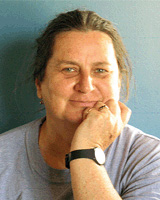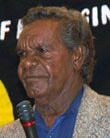Introduction
Background to Yuendumu and the Old People's Programme
Yuendumu, the largest Aboriginal community in Central Australia, has a fluctuating population of approximately 1100 Warlpiri people, and is situated 300 km north-west of Alice Springs on the edge of the Tanami Desert (Fig1). The people (who refer to themselves as Yapa) speak predominately Warlpiri with English as a second or third language.
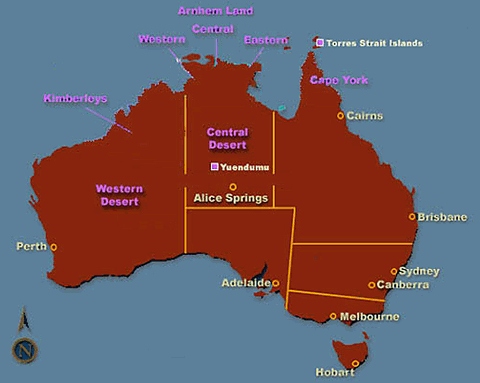
Figure 1: Map of Australia locating the community of Yuendumu.
Yuendumu was established as a ration depot and mission in 1946 with a then estimated population of 3501. Much of the work of old people in their youth was for government rations not wages2. As part of this 'welfare time', government rations were distributed at Yuendumu from the 1940s until 1970s. A community kitchen and dining room was also in operation from the early 1960s. After communal food provision ended, there were community reports of under-nutrition in young children and the elderly. After the end of the 'welfare time', local women started providing meals to old people from a base at the local health clinic. Later, a community based Meals on Wheels service commenced and in 1988 the Yuendumu Women's Centre was established to support this service with funds from the Home and Community Care (HACC) program of the national government (Commonwealth Government). In 1993, the Women's Centre employed a Project Officer for a training and development project (the present lead author). At this time, a large number of old people from Yuendumu were living permanently in nursing homes 300 km away in the town of Alice Springs. Territory Health Services (managed by the Northern Territory Government), for the first time in Central Australia, seconded two Aboriginal health workers to provide personal care services at the outset of service development.
As is common in remote Aboriginal communities, the economic context of Yuendumu is characterized by high unemployment rates, low household incomes and poor standards of housing. There is a range of service providers in Yuendumu, including the Women's Centre, Health Clinic, Warlukurlangu Arts Centre, Youth Services, Warlpiri Media Association, police, two locally owned shops, education services and the Community Council. All these services impact directly or indirectly on the quality of life of old people. Non-Aboriginal professionals administer most of these services.
Included in this range of service providers is an aged care service known as Yuendumu Old Peoples Programme (YOPP). This case study aims to describe, from the analytic standpoint of community control and cultural comfort, the main features of the 'Family Model of Care', which underpins the operations of the service and the YOPP management processes.
Methods
Sources of information
This case study was undertaken based on 16 years of participant observation in the development, implementation and management of YOPP. In developing this case study, the authors reflect on the experience and discuss issues with reference to relevant international, national and Programme literature and documentation between 1993 and 2009.
The first author was the YOPP facilitator for 11 years between 1993 and 2004. This participation has provided a rich source of information in terms of historical record, and the continuous engagement in management and delivery of services has enabled participant insight into the evolution of YOPP. While working in YOPP the first author kept a daily journal. From this journal, monthly and six-monthly reports and annual reports were written for the funding body and Steering and Management Committees. Additional historical material was recorded in two video documentaries produced in 1995 and 20043,4. The third author is the senior Warlpiri community member overseeing the local Management Committee. It is the cultural perspective of the third author and his community members that has provided the main cultural frame for the shaping of YOPP that is documented in this article.
Limitations and scope of the case study
In conducting the literature review, very little published material was found about aged care in remote Aboriginal communities, and no material described an Aboriginal cultural framework for developing or delivering aged care services. Additionally, at the outset of this project there was an absence of accurate baseline data regarding the community of origin of Aboriginal people permanently residing in Alice Springs nursing homes, which is a limiting factor in describing Programme impact. However, the emphasis in this article is on quality of care, with the description of cultural processes being central to the definition of quality and the model of service delivery. In addition, while a comprehensive account of the development and operations of YOPP cannot be provided, the most significant features believed to be of benefit to other aged care programs in Indigenous communities have been highlighted. Finally the authors acknowledge that neither testing aged care clinical standards nor formal evaluation of community perceptions of quality of care were objectives of this article. Rather, the primary aim was to describe the development of a Family Model of Care and articulate the role of cultural and community factors in shaping the aged care program.
Approach
The development of YOPP was based on action research principles and problem solving strategies. Essentially this means that the workers negotiate current priorities to address using the Action Research Cycle of: identify and plan - act - observe - reflect/evaluate. This process allows existing services to be consolidated and improved while identifying and trialling ways to meet new issues as they arise5. In an unpredictable environment with constant community disruption, this method of continuous consolidation and review assists to keep planning informed by the immediate needs of the client group and enables response to unforeseen circumstances. It also enables the development process to accommodate the core Warlpiri values of immediacy, mobility and intimacy that influence the priorities of everyday life in the community6. These values are shaped by notions of time and space, kinship and country. High value is placed on orientation to the present, meeting needs as they arise, being in the close company of family members, on-going negotiation of social relationships and responsibilities, and, continual movement within and among camps and other Warlpiri communities (Figs3,4)1,6.
Frameworks for development and analysis - concepts of cultural comfort and community control
The concepts of 'cultural comfort' and community control are fundamental to understanding the rationale for the design and mode of management and operations of YOPP.
From the outset of the development process the aim has been to minimize the number of old people in the community being permanently admitted to Alice Springs' nursing homes by providing support and respite services to enable them to live in their family groups and 'finish up' (pass away) in their own country. To achieve this, services need to be provided to ensure cultural comfort.
The concept of cultural comfort means that service provision is informed by, and provided from within, Warlpiri cultural practices rather than Warlpiri needs being accommodated within another cultural construct. This approach is similar to the notion of cultural safety7,8, which directly links service actions with protocols and procedures according to local practices9. Furthermore, cultural safety involves a critical examination of the power imbalances in healthcare encounters between Indigenous clients and non-Indigenous healthcare providers10. Cultural comfort is an expansion of this concept of cultural safety, in that it recognizes local culture as being the starting point for the design of service provision, rather than being a factor in design that needs to be accommodated to a mainstream culture.
The concept of 'community control' is also central to the design and operations of YOPP. Community control means that planning is undertaken at the community level according to the priorities set by community people and their perceptions of the timing and pace of development. It also involves the notion of building community capacity so that individuals and communities can better address and manage their own care needs11. This being the case, the community control approach is considered a central strategy to addressing the social determinants of health through enhanced accessibility to healthcare services12. In practical terms, this means that management of the day-to-day activities of services should be in the hands of local people12. A Programme Development Plan from 2000, which included an evaluation of the existing Programme, indicated that local cultural constructs such as the Family Model of Care, the kinship system and the local governance model were all attributed as being main factors in the very high acceptance of the service by community members13.
From the analytic standpoint of community control and cultural comfort, this case study aims to describe the main features of the 'Family Model of Care' that underpins the operations of YOPP. The article will also discuss the implications of this aged care delivery model as a strategy for community development and enhancement of quality of care.
Results
The Health Needs of the Aged in Yuendumu
In 1993 there were many old people from remote Aboriginal communities in Central Australia residing permanently and reluctantly in nursing homes in Alice Springs14. In Yuendumu at this time there were no records of old people, either in nursing homes or in family camps, available in the community. Thereafter, Clinic records and the old Welfare family records book (locally known as the 'stud book'), were used to compile an annually updated YOPP register of all those over 50 years of age. In 2001, approximately 10% (110) of the population were identified as 'aged'. Most of these were widows living in single women's camps or with young family members. All, except the very frail and infirm, were involved in the cultural and ceremonial life in the community.
The healthcare needs of the old people are both chronic and acute. The Old People's Programme maintains a high proportion of 'high care' clients in the community. While it is possible to support people to 'age in place', medical interventions often result in referrals to higher levels of the healthcare system which results on occasions in old people not 'dying in place'15. For the first 5 years of YOPP's increased service provision and planned respite care, no one from the community was permanently placed in an Alice Springs nursing home. Since then, four to five individuals at any one time have lived permanently in a nursing home in Alice Springs16.
Client numbers remained fairly constant during the period of this case study with 25-35 clients (of which 15-17 would be considered 'high care' mostly being frail aged people, but also including those with conditions such as dementia, suffering from immobility and/or requiring continence management). The birth cohort of this initial client group preceded the settlement period and consequently lived nomadic, traditional life styles as children and young adults. Recent years have seen the emergence of a younger client group with chronic health problems such as diabetes and renal failure related to the more sedentary life styles of the settlement period16.
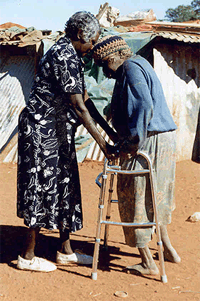
Figure 2: Senior Worker with client.
The development of YOPP
In the early 1990s there were no precedents for aged care services beyond basic Home and Community Care services in remote Aboriginal communities. However, the Commonwealth Government was supportive of communities negotiating locally appropriate services. These were supported by the Aboriginal and Torres Strait Islander Aged Care Strategy17. After a period of Pilot Project funding (1997-2002) YOPP began to receive funding as a Flexible Aged Care Service in 2002, with the 'flexible service' design of a mix of residential and community based aged care services18.
Male and female Old People's Forums were established in 1994 to provide direction to the evolving services at YOPP. This was followed in 1995 by the establishment of a Steering Committee with equal numbers of men and women. In 2000, YOPP became a separately incorporated body (Mampu Maninja-kurlangu Jarlu Patu-ku Aboriginal Corporation). The Women's Centre and Steering Committee handed over authority to a Management Committee that represents all Yuendumu families through the Warlpiri kinship system ('skin groups'). In 2001, the 'Ngurra Mampu Maninja-kurlangu Jarlu Patu-ku' (house/place for looking after old people) was opened.
In 2008, Frontier Services (the largest aged-care provider in the Northern Territory, governed by Uniting Church Australia) entered into a one-year contract with YOPP to provide mentoring and capacity building. The mentoring involved advice, support and the resources to deliver an aged care service that, while meeting increasing government requirements for standards of care, is maintained through local community control.
As a result of these developments, YOPP has been supportive of old people staying with their families in the community and to 'finish up' (pass away) in their country. A 1993 needs analysis19, minutes of YOPP Management Committee meetings20, and the Constitution of YOPP21 record the concern of old people and others in the community regarding community members permanently resident in nursing homes in Alice Springs (and subsequently passing away outside traditional country), and the expressed and related need to develop community based quality aged-care services. Despite not being the largest Aboriginal community in the Northern Territory, Yuendumu has the highest number of high care old people in the community. The last decade has seen an average of only four elderly people (of an average population of 100 elderly) permanently residing in nursing homes in Alice Springs22.
The Service delivery model - 'The Family Model of Care'
Principles of operation: The concepts of cultural comfort and community control are embedded in the model of service delivery that came to be referred to as 'The Family Model of Care.'
Yuendumu Old People's Programme is based in the traditional values, skills base and worldview of Yapa. 'Hands on' services are delivered primarily by local people who speak Warlpiri and are known to the client group. They function within local cultural protocols (Fig3), and hence are uniquely positioned to understand and accommodate the day-to-day activities and concerns of the clients. That is, the 'commonsense' behaviors of Warlpiri society are applied to the service delivery model.
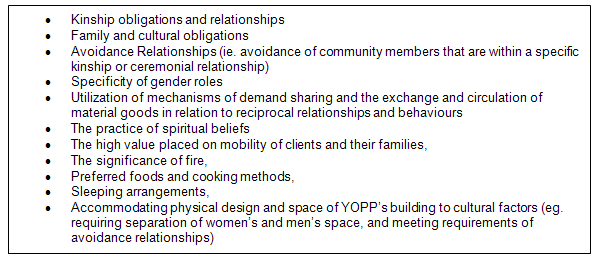
Figure 3: Subject areas of cultural protocols.
Mainstream concepts of quality of care are acculturated within a Warlpiri worldview. The Warlpiri worldview incorporates people's local reality, their wishes and ways of thinking, priorities, needs and constraints. As part of this worldview, care is provided within the context of the obligations and responsibilities of the Warlpiri family and skin group system. This kinship system provides the main framework within which the Warlpiri make significant decisions, as well as defining the network of correlative roles and social behaviors23.
Traditionally it was 'kin' rather than 'the community' who cared for the aged and the weak. In Warlpiri culture, the old people are the 'keepers of culture'. This being so, the workers must have the right standing in the community and be trusted to look after old people who have contributed significantly to the ceremonial and social life of the community. It is recognised that the client group 'grew up' the young people and, in return, the young people are now required to help24.
Figure 4 provides more explanation of the skin group system and its applicability to the aged-care context.
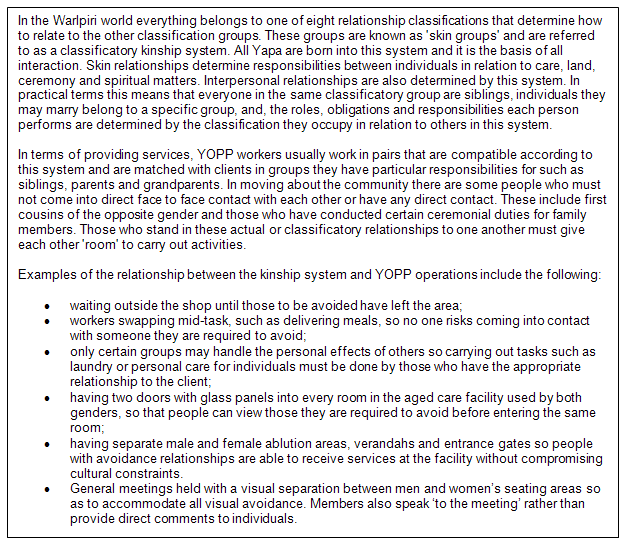
Figure 4: The Kinship System in the context of aged care.
The focus in the Family Model of Care (Fig 5) remains on community control and ownership, which is achieved by the activities of the:
- Management Committee, consisting of elected Yapa members only and representing each of the 8 skin groups, so as to be responsible to the old people and family carers
- local Yapa workers who deliver the services directly to the people according to cultural obligations and responsibilities
- operational management, whereby a respected Yapa Senior Worker is responsible also for the overall day-to-day management of YOPP.
This model emphasises, reinforces and supports family care, as opposed to the more mainstream institutional human service model. It reflects the mission of YOPP to maintain old people in their families and in their country, even when they are very frail and have high care needs, and to help them to 'finish up' (pass away) in their community25.
YOPP aims to improve the quality of life and quality of death for old people and keep them living in their country with their families. We are moving away from institutional care back to the family model of care that once was so strong15.
Methods of operation: This Family Model of Care emphasizes the relationship between culture, control and self-reliance, and connection with the wider community.
Cold weather is here and everyone has to help old people. It is too big a job for the Old People's Programme by itself25.
There are three ways for community members to initiate care and comment on or evaluate the appropriateness of the services. These are through the Management Committee, Senior Worker and/or Project Worker and the Aged Care Workers. Any member of the community can approach appropriate Management Committee members or workers with issues of concern without breaching cultural protocols.
The workers are mobile in the community on a daily basis. Families and old people can contact YOPP either through these community rounds and camp visits or by coming to Ngurra Mampu Maninja-kurlangu directly. The aged care workers visit families, and informal assessments are conducted of old people's needs. The service is responsive in terms of who will deliver the service, what sort of service, and for how long. If a problem is not too large, workers can commence providing services directly. Examples of service provision include provision of meals, laundry, transport, personal care, support for activities of daily living, day care, respite care, recreational supports and wellbeing checks and health referrals.
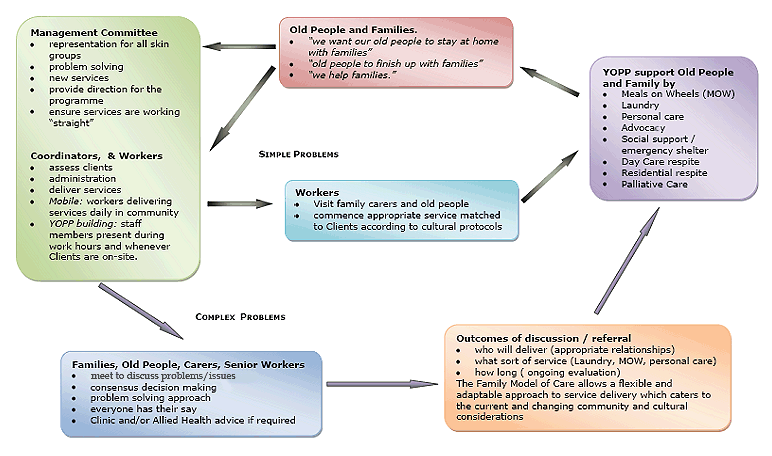
Figure 5: The Family Model of Care.
If there is a complex situation, a meeting will be organised by YOPP with the family, workers and health clinic staff to determine a care plan for the old person. If the issue is more than a service provision matter it may need to be taken to the Management Committee. As an outcome of these discussions, referral is provided that enables the appropriate level of service to be delivered. In this way, service provision can respond to the cultural, family and physical needs of old people. Review and evaluation is on-going with all parties by the involvement of all 'skin groups' in the management and organisation of care.
The advantages of the Family Model of Care include the following:
- reinforcement of Warlpiri social systems
- skill building within family groups to care for old people
- care planning and review that is responsive to the expressed needs of the old people and their families
- continued access to care for old people even during 'sorry' (mourning ceremonies), because the carers are in the ceremonial group
- employment for community members
- enablement of community members to access support services without compromising cultural protocols.
Strategies put in place by YOPP have also benefited the whole community. These include provision of washing machines throughout the community (resulting in greatly improved skin conditions and general hygiene), and an open approach to employment and training (enabling community members to develop care skills that improve family and community safety). Employment with YOPP has provided many women in the community with the opportunity to extend their knowledge of nutrition and cooking.
The process of managing YOPP
The Old Peoples Programme's management is based on three approaches: (i) participation and input from clients: (ii) Aboriginal driven management structure and processes; and (iii) consensus decision-making.
Participation: There are a range of strategies for accommodating participation and input from clients. Independent incorporation ensures, through a legal entity, that there is an organisation dedicated to old people in the community that is not subjected to the changing priorities of sponsor bodies. Membership of the organisation is open to people permanently living in Yuendumu over the age of 50 years, workers who have been employed for more than 12 months and anyone the Management Committee considers works for the benefit of old people.
Kinship relationships and obligations are accommodated by YOPP by having a number of people who can be approached if someone has a problem or concern about the service. Workers are matched with clients to ensure cultural protocols are maintained. The workers also self-select their working partners according to these protocols.
Aboriginal management structure: To ensure all family groups are represented in YOPP and to reflect the client gender ratio, the Management Committee consists of eight women (representing every skin group) and four men (representing every father/son group).
The Management Committee is elected by YOPP's membership and meets with the workers formally and informally on a regular basis to ensure they are 'keeping on track'. The Senior Worker and workers are available on a daily basis as they deliver services in the community. Non-Yapa workers are available at the aged care centre and by telephone at the Alice Springs administration office and jointly provide health and social services to the aged when required.
The Management Committee is responsible for dealing with the direction of YOPP, planning, complaints, problem solving and ensuring the services are 'straight' (a colloquial term meaning honest and according to the rules). The Committee meets regularly with special meetings held as required, and annual general meetings are held with all members of the Corporation. Committee members are available to workers for advice, support and approvals. The Senior Worker is responsible for the day-to-day issues of service delivery, monitoring YOPP, supporting and training staff. She is available to review a situation, organise family meetings and ensure that the service is adaptable to the cultural activities of the community.
Consensus decision-making: Workers make decisions through a consensus process, following discussion with the appropriate people/services. This is facilitated by management activities that include senior staff discussion, family meetings, Management Committee meetings, annual general meetings with clients and members, monthly meetings with Clinic staff and ongoing communication with family carers.
The Management Committee also makes decisions by consensus. Decisions are deferred if agreement cannot be reached. The men and women will sometimes hold different views of how best to address an issue. Each view point is heard during meetings but consideration and discussion of issues take place in family groups. Meetings are forums to examine information and reach agreement, rather than to debate issues and argue a particular stance. This can make decision-making a slow process but leads to well-considered decisions that maintain accord in the group. During the period of this case study many serious social and political matters, both from within the community and the outside world, were successfully resolved by the Management Committee22.
Sustaining Yuendumu Old People's Programme
The Old People's Programme is able to accommodate some of the community, social and cultural needs of the people. Staffing levels can be erratic when family and community life demand the attention of the workers. However, there is a large pool of casual workers to be drawn on. For example, on most occasions of service disruption due to other local matters, people who are able will come forward and work in YOPP. In this way family obligation or cultural commitment is usually met with minimal disruption to service delivery. In recent years there has also been some ceremonial adaptation to allow workers to maintain service provision during ceremonial periods.
The legacy of welfare dependence combined with social and political upheavals, high rates of trauma and death, the extreme physical environment and complex cultural issues all lead to difficult situations to negotiate and navigate, making it very difficult for short term outside or non-Yapa employees to work effectively with local people. Consequently, the importance of long term personal relationships cannot be underestimated in sustaining the success of service provision in a cross cultural setting. These relationships are able to initiate and accommodate change over time, rather than implement new ideas quickly that cannot be sustained.
Continuity, stability and appropriate working relationships within YOPP have been further maintained and restored through the Management Committee's commitment to local control and the employment of local workers, in keeping with cultural considerations. The daughters, sons and grandchildren of the original local workers and committee members are the current workers in YOPP.
Development of the services provided by YOPP has been progressed by the community development practices of support and skills development of local people by outside professionals who do not have a permanent presence in the community. A central sustainability strategy in the development of Aboriginal governance was therefore the '2 week in - 2 week out' approach adopted by the non-Yapa Project Worker. This approach to development partnerships (intermittent presence of specialists in the field) has been noted in other development contexts26,27.
The sustainability strategy works through the promotion of self-reliance among the local aged care workers and their managers, and ensures continuity of the non-Yapa Project Worker position by preventing 'burn out'. This reinforces local ownership, independence and provides space for culturally appropriate practices to be determined. Yapa workers are able to be 'bosses for themselves' while knowing that support will return. In this sense, the Project Worker acts as a 'change agent', 'mobiliser' or 'facilitator' and the Senior Yapa Workers and key Committee members are 'animators' of the development effort26. The skills of the workers are developed by formal and informal training that utilises Aboriginal learning behaviours of modelling, observation and imitation, trial and error and real-life application28.
Discussion
Community development context of aged care
Given the history of welfare dependency and the emphasis on cultural and family models of care, there is a strong emphasis in YOPP on self-reliance. In a community development context, this means building on the traditional precedent of caring for old people to develop capacity. In this way the local organization and local workers are enabled to work with families and to care for old people in a flexible and culturally appropriate way. It also means assisting families to maintain traditional ways of caring for older family members while providing new support services to complement and sustain traditional patterns of care.
Working in a community development context involves matching workers' priorities and needs with those of the service. For this to occur, flexibility in relation to time management and changing personal and community priorities is required. Finding culturally sustainable ways of meeting the needs of the client group and of the local workers as individuals and culturally responsive members of Warlpiri society is required. A trial and error approach to service planning is needed to accommodate a Warlpiri way of delivering services.
Culture is, therefore, not seen as something at the margins of a service delivery framework. It is at the centre of development29. Culture operates through the way YOPP is managed by the skin-group based Management Committee. Culture operates in the service delivery system via kinship relations among workers, clients and 'country'. Culture is at the centre of the physical infrastructure of YOPP, which is designed to accommodate the traditional organisation of domestic camps, gender relationships to space, and avoidance relationships. Finally, culture is placed at the centre of personal care because the primary provision of care is by Warlpiri people for Warlpiri people.
It is important to understand that accommodating a Warlpiri worldview into the pattern of service delivery goes beyond a statement of recognition by mainstream services of culturally mediated alternative patterns of service delivery. Associated mainstream services must also adapt their service delivery pattern and management in order to accommodate this Warlpiri worldview. This is because working at the aged care cultural interface means change from both sides, not the least of which is a recognition of 'mutual paradigms of competence' between the two groups30. This involves a way to be found for both cultures to understand each other's values and priorities. In practical terms this requires agreed communication mechanisms for operations, which in the YOPP case includes the Management Committee, the Family Model of Care and national standards and guidelines for aged care practice. In particular, it is the centrality of culture to management and service provision that provides 'cultural comfort' and enables the provision of optimal quality aged care services in an Indigenous setting.
The challenge of having two cultural paradigms interacting in the health sector has also been observed in the legal sector. For example, strategies for Aboriginal dispute resolution are said to 'maximize and enhance the role of community elders and organizations and minimizes... the reliance on external agencies and inappropriate dispute resolution mechanisms'31. However, sole reliance on external agencies was said to have contributed significantly to 'the disempowerment of Aboriginal people in law and justice on these communities'31. In the same way, sole reliance on mainstream health and urban aged care services was viewed as contributing to the disempowerment of family and community based aged care in Yuendumu. This was therefore viewed as impacting negatively on quality of care by denial of family and old people's aspirations to live and die in traditional country.
This observation has been supported by a recent review on end of life care for Indigenous people in Australia, which established that a lack of Indigenous respite services in rural and remote areas was obstructing patients' wishes for their death to occur in the local community, and resulting in many patients dying in far away cities32.
The structure and function of YOPP is, therefore, consistent with the fundamental principles of community development, particularly in regard to the promotion of self-reliance, community ownership and careful management of outside external expertise33.
Ideas of quality of care in a cross cultural context
If judged according to the 'efficiency standards' of non-Aboriginal organizational culture, Warlpiri decision-making processes can be seen as slow. However, this process, which requires the provision of time to consider and discuss issues with others before making decisions, demonstrates the importance of cultural values and local ownership. This considered approach to decision-making adapts new ideas to local conditions and cultural factors, which serves to raise standards of care in a social rather than institutional context. This changing and raising of standards is integral to YOPP concepts of quality and is dependent on cultural sustainability as well the community ownership and direction of YOPP.
This balancing of social and professional perspectives is central to concepts of quality. Yuendumu Old People's Programme is intent on developing services with a quality of care consistent with national standards and guidelines. And in keeping with such guidelines, YOPP is intent on providing a community directed service adapted to local cultural and social conditions.
Ideas of 'quality of care' are, therefore, not centered only on standards of medical competence. Culture is also at the centre of care, and so quality begins with issues of traditional law, country, and kinship. Mainstream services are accommodated within this quality concept by being accountable to a management system governed by the structures and functions of tradition. The local Management Committee, organized along kinship lines and operating according to the Family Model of Care, is the principal mechanism by which problems are solved, family issues are negotiated, and care is organized. The presence of the Project Worker at Committee meetings ensures there is always a pathway of communication between the service providers and community leaders.
Honoring clients' right to decline services and advocating on their behalf to 'age and die in place' are important aspects of the organisation's cultural responsibilities. Rather than accepting the concept of a dominant mainstream culture, YOPP demonstrates that there are, in fact, two 'coherent and competent societies in relationship'30. Local acceptance and the effectiveness of YOPP is dependent on recognition of a paradigm of mutual competence, and the development of practices by mainstream professional carers that are supportive of traditional systems of care based on traditional law, kinship and country as well as on standards of medical and aged care competence. In this sense, discussions of 'community control' and 'cultural comfort' are not merely 'holistic' concepts of Aboriginal health that can justify any answer to a policy question34, but can also have practical applications in the everyday setting of community based aged care.
Conclusion
Yuendumu Old People's Programme emerged from a long period of 'welfarism' to become a meals on wheels service and then, in 2009, a more comprehensive community controlled aged care service. The needs of the old people in Yuendumu are regarded as significant, based on the particular social and economic conditions of poverty and remoteness, and the desire of the old people to live and die in their traditional country. The key lesson of this case study is that it is feasible to promote high levels of cultural comfort and community control in an Indigenous aged care setting, and that these characteristics should be used to assess quality of care in such a context, along with the accommodation of medical and mainstream aged care standards. The Old People's Programme has demonstrated these characteristics in helping to meet the needs of the old people by placing culture at the centre of service provision, and devising management and operational principles and strategies that ensure that the old people have the best chance of 'ageing and dying in place', close to family and country.
Acknowledgements
The authors recognize for their contribution to the development of YOPP: the Commonwealth Department of Health and Ageing, the Aged Care Workers of YOPP, the Management Committee of YOPP, many senior Yuendumu community members who have now passed on, and Flinders University (Centre for Remote Health). Special thanks are extended to Christine Lennard, Dr Melissa Lindeman and Lorraine Nungarrayi Granites for their assistance with the content, and to Flinders University for financial assistance through a bursary (PHCRED).
References
1. Meggitt MJ. Desert people. London: Angus and Robertson, 1984; 33.
2. Rowse T. White flour, white power: from rations to citizenship in Central Australia. Cambridge: Cambridge University Press, 1998.
3. CAAMA Productions, Warlpiri Media. Yuendumu Old Peoples Programme. Alice Springs, NT: Warlpiri Media Association, 1995. (Video)
4. Fleming RN. Mampu Maninja-kurlangu: caring for old people Yapa way. Yuendumu, NT: Warlpiri Media Association & Yuendumu Old People's Programme, 2004. (Video)
5. Field L. Skilling Australia. Sydney, NSW: Longman Cheshire, 1990.
6. Musharbash Y. Yuendumu everyday: contemporary life in remote Aboriginal Australia. Canberra, ACT: Aboriginal Studies Press, 2008.
7. Williams R. Cultural safety--what does it mean for our work practice? Australian and New Zealand Journal of Public Health 1999; 23(2): 213-214.
8. Johnstone MJ, Kanitsaki O. An exploration of the notion and nature of the construct of cultural safety and its applicability to the Australian health care context. Journal of Transcultural Nursing 2007; 18(3): 247-56.
9. Coffin J, Drysdale M, Hermeston W, Sherwood J, Edwards T. Ways Forward in Indigenous Health. In: Liaw S-T, Kilpatrick S (Eds). A Textbook of Australian Rural Health. Canberra, ACT: Australian Rural Health Education Network, 2008; 141-150.
10. Peiris D, Brown A, Cass A. Addressing inequities in access to quality health care for indigenous people. Canadian Medical Association Journal 2008; 179(10): 985-986
11. Anderson I. Recent developments in national Aboriginal and Torres Strait Islander health strategy. Australia and New Zealand Health Policy 2004; 1: 3.
12. Wakerman J, Humphreys JS, Wells R, Pim K, Entwistle P, Jones J. Primary health care delivery models in rural and remote Australia: a systematic review. BMC Health Services Research 2008; 8: 276.
13. Smith K, Grundy J, Conlon N. Development Plan Mampu Maninja-Kurlangu Jarlu Patu-Ku Aboriginal Corporation. Alice Springs, NT: Centre for Remote Health Flinders University/NTU, 2000.
14. Harrison J. Social policy and Aboriginal people: In: A Borowski, S Encil, E Ozane (Eds). Ageing and Social Policy in Australia. Cambridge: Cambridge University Press, 1997.
15. Wallit C, Granites L. In: Proceedings, CARPA Palliative Care Conference; June 1999; Alice Springs, NT; 1998.
16. Smith K. Yuendumu Old People's Programme. Annual Reports. Yuendumu, NT: Yuendumu Old People's Programme, 1993-2004.
17. Department of Health and Ageing. National Aboriginal and Torres Strait Islander Aged Care Strategy. Canberra, ACT: DoHA, 1993.
18. Borowski A, Encel S, Ozanne E. Longevity and social change in Australia. Sydney, NSW: University of New South Wales Press, 2007; 79.
19. Smith K. Training needs assessment for Yuendumu Women's Centre. Alice Springs, Australia, 1993.
20. Mampu Maninja-Kurlangu Jarlu Patu-Ku Aboriginal Corporation. Meeting Minutes. Yuendumu Old People's Programme Yuendumu, 1999-2009.
21. Mampu Maninja-Kurlangu Jarlu Patu-Ku Aboriginal Corporation. Constitution. Yuendumu, NT: Old People's Programme Yuendumu, 2001.
22. Mampu Maninja-Kurlangu Jarlu Patu-Ku Aboriginal Corporation. Annual Reports. Yuendumu, NT: 1993-2009.
23. Rowse T. Remote possibilities - the Aboriginal domain and the administrative imagination. Darwin, NT: ANU Books, 1992; 51.
24. Fleming R, Nelson H. Mampu Maninja-kurlangu: caring for old people Yapa Way. Warlpiri Media Association & Yuendumu Old Peoples Programme, 2004. (Video)
25. Kumunjayi Nungarrayi Granites. Old People's Programme. Jungu Yimi Magazine 1995; 4(1): 19-95.
26. Burkey S. People first: a guide to self-reliant participatory rural development. London, UK: ZED Books, 1996.
27. Kelly A. People centred development - working with communities: a methodology of engagement. Brisbane, QLD: Centre for Social Response, 2008.
28. Harris S. Culture and learning: tradition and education in North East Arnhemland. Darwin, NT: Department of Education, 1980.
29. Coleridge P. Disability and Culture. Asia Pacific Disability Rehabilitation Journal 2000; 2: 21-38.
30. Folds R. Crossed purposes: the Pintupi and Australia's Indigenous policy. Sydney, NSW: UNSW Press, 2001.
31. Brown G, Hayes M. The role of community organisations, elders and traditional owners in Aboriginal dispute resolution. In: Proceedings, Reconciliation Australia Conference; 2-5 April 2002; Canberra, ACT, 2002.
32. McGrath P, Patton M, McGrath Z, Ogilvie K, Rayner R, Holewa H. 'It's very difficult to get respite out here at the moment': Australian findings on end of life care for Indigenous people. Health and Social Care in the Community 2006; 14(2): 147-155.
33. Ife J. Community Development. Melbourne, VIC: Longman, 1999.
34. Lutschini M. Engaging with holism Australian Aboriginal Health Policy - a review. Australian and New Zealand Health Policy 2005; 2: 15.
